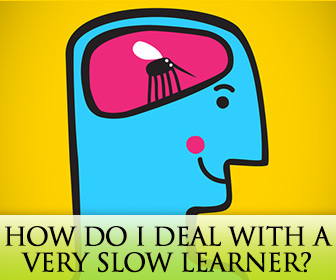“I’m having a problem with a student who is a terribly slow learner. This student is an eight-year-old boy who seems to grasp very little and speaks even less. He does not remember half of the new words I teach the class and gives mostly one-word answers (yes/no). What can I do to help him?” *
Every ESL teacher has to deal with slow learners at one point or another.
Slow learners come in all shapes and sizes; they can be children or adults; they can come from any nationality or educational background. While it is a big challenge for everyone involved, there is a great deal your slow learners can achieve. Here are some tips for managing slow learners in your ESL class.

Try These 7 Tips for Dealing with Slow Learners
-
1
Rule out a Learning Disability
Your particular slow student may have a problem like dyslexia, a sensory impairment or even an intellectual disability.It may not be the most common problem you’ll encounter in an ESL classroom, but it is a possibility you need to rule out. Your particular slow student may have a problem like dyslexia, a sensory impairment or even an intellectual disability. If you suspect there may be an underlying learning disability, you’ll need to speak to your supervisor first before approaching the parents. Then, you’ll need to call a meeting with the parents to find out whether the student has been diagnosed, and depending on their answer, you’ll determine what should be done next. All of this has to be handled very carefully. But never assume that this is not a possibility. I’ve had ESL students with dyslexia, and I once taught a 5-year-old girl who clearly was mentally disabled but whose mother was in denial.
-
2
Rule out Other Problems
There are slow learners, shy learners and learners who are simply not motivated. And you must be able to discern which group your particular student falls into. Shy learners are not necessarily slow; their problem often lies in speaking out loud and a lack of confidence. Students who are not motivated are simply not interested and need to be engaged in order to participate fully in the class. Finally, slow learners are students who are not able to follow the current pace, i.e. they don’t learn as fast as the rest of the class. If you’ve ruled out any physical or mental disabilities, this simply means that learning a second language is harder for this particular student. And that’s all.
-
3
Give them Tools
Quite often, the problem with the slow learners who do not remember things is that they have not been given the kind of tools that work for them. It may take a little digging and some extra effort on your part, but ask yourself: if this student has trouble remembering/understanding things, what could he/she do that will help them remember/understand? Suggest that they keep a Word Book, for example, and that they write in it every day. Give them “cheat sheets”, lists of verbs, charts with verb tenses. Maybe they’re not slow, but rather very visual learners, and they need to “see” to remember.
-
4
Celebrate Small Successes
Both the ESL teacher and the slow learner must understand one essential thing: the problem is not that the student can’t learn, but rather that they do so at a different pace. Sometimes they simply take longer and that’s all. So there will be plenty of successes for you to celebrate. Don’t forget to encourage and offer praise. It will boost self-confidence and help your slow learner keep putting in the effort to learn.
-
5
Pair Them with Strong Learners
When dividing the class into groups or teams, try to pair the slow learner with a buddy who can guide him/her. Also, always encourage respect towards those who simply don’t “get” things as fast as the rest. More often than not, they do get it in the end!
-
6
Arrange Extra Tutoring
Some extra tutoring sessions can do wonders for slow learners. With the added pressure of competing with the rest of the class, they often flounder during drilling or quick-paced activities. But once you get them on their own, in a quiet tutoring session, they start seeing things fall into place. They simply have different learning times and needs.
-
7
Go the Extra Mile
You may need to repeat instructions to the slow learner one more time. You may need to give them the instructions in writing. You may need to spell it out, copy it down, repeat, and then repeat again. Be patient with the slow learner. They don’t learn well under pressure or in a hurried setting. You may have to go the extra mile, but it will be totally worth it when you see your slow learner has achieved his/her goals.
Slow learners are exactly that and nothing more – they are slow.
That does not mean they are worse students, or that they won’t achieve their goal of learning a second language. It simply means they need to do so at their own pace.
* This question was sent in from a real ESL teacher, just like you! If you need any advice on a particular topic, share your question in the comments below. Or tweet your question to @busyteacher_org with the hashtag #ESLTeachersAsk. Your question might get picked and featured in an article!
P.S. If you enjoyed this article, please help spread it by clicking one of those sharing buttons below. And if you are interested in more, you should follow our Facebook page where we share more about creative, non-boring ways to teach English.







